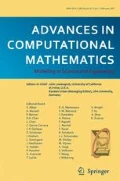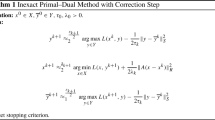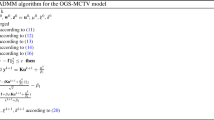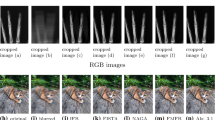Abstract
Recently, optimization algorithms for solving a minimization problem whose objective function is a sum of two convex functions have been widely investigated in the field of image processing. In particular, the scenario when a non-differentiable convex function such as the total variation (TV) norm is included in the objective function has received considerable interests since many variational models encountered in image processing have this nature. In this paper, we propose a fast fixed point algorithm based on the adapted metric method, and apply it in the field of TV-based image deblurring. The novel method is derived from the idea of establishing a general fixed point algorithm framework based on an adequate quadratic approximation of one convex function in the objective function, in a way reminiscent of Quasi-Newton methods. Utilizing the non-expansion property of the proximity operator we further investigate the global convergence of the proposed algorithm. Numerical experiments on image deblurring problem demonstrate that the proposed algorithm is very competitive with the current state-of-the-art algorithms in terms of computational efficiency.
Similar content being viewed by others
References
Ma, S., Yin, W., Zhang, Y., Chakraborty, A.: An efficient algorithm for compressed MR imaging using total variation and wavelets. In: IEEE Conference on Computer Vision and Pattern Recognition, CVPR 2008, pp. 1–8. IEEE (2008)
Cands, E.J., Romberg, J., Tao, T.: Robust uncertainty principles: Exact signal reconstruction from highly incomplete frequency information. IEEE Trans. Inf. Theory 52(2), 489–509 (2006)
Donoho, D.L.: Compressed sensing. IEEE Trans. Inf. Theory 52(4), 1289–1306 (2006)
Figueiredo, M.A.T, Nowak, R.D.: An EM algorithm for wavelet-based image restoration. IEEE Trans. Image Process. 12(8), 906–916 (2003)
Moreau, J.-J.: Proximité et dualité dans un espace hilbertien. Bulletin de la Societé Mathématique de France 93, 273–299 (1965)
Daubechies, I., Defrise, M., Mol, C.D.: An iterative thresholding algorithm for linear inverse problems with a sparsity constraint. Commun. Pure Appl. Math. 57(11), 1413–1457 (2004)
Combettes, P.L., Wajs, V.R.: Signal recovery by proximal forward-backward splitting. Multiscale Model. Simul. 4(4), 1168–1200 (2005)
Hale, E.T., Yin, W., Zhang, Y.: A fixed-point continuation method for l1-regularized minimization with applications to compressed sensing. CAAM TR07-07, Rice University (2007)
Wright, S.J., Nowak, R.D., Figueiredo, M.A.T.: Sparse reconstruction by separable approximation. IEEE Trans. Signal Process. 57(7), 2479–2493 (2009)
Bioucas-Dias, J.M., Figueiredo, M.A.T.: A new twIST: two-step iterative shrinkage/thresholding algorithms for image restoration. IEEE Trans. Image Process. 16(12), 2992–3004 (2007)
Beck, A., Teboulle, M.: A fast iterative shrinkage-thresholding algorithm for linear inverse problems. SIAM J. Imag. Sci. 2(1), 183–202 (2009)
Goldstein, T., Osher, S.: The split Bregman method for L1-regularized problems. SIAM J. Imag. Sci. 2(2), 323–343 (2009)
Combettes, P.L., Pesquet, J.-C.: A Douglas-Rachford splitting approach to nonsmooth convex variational signal recovery. IEEE J. Sel. Top. Sign. Proces. 1(4), 564–574 (2007)
Setzer, S.: Operator splittings, Bregman methods and frame shrinkage in image processing. Int. J. Comput. Vis. 92(3), 265–280 (2011)
Esser, E.: Applications of Lagrangian-based alternating direction methods and connections to split Bregman. UCLA CAM Report, 9–31 (2009)
Chen, D.-Q., Cheng, L.-Z., Fang, S.: A new TV-stokes model with augmented Lagrangian method for image denoising and deconvolution. J. Sci. Comput. 51(3), 505–526 (2012)
Chen, D.-Q., Zhou, Y.: Multiplicative denoising based on linearized alternating direction method using discrepancy function constraint. J. Sci. Comput. 60(3), 483–504 (2014)
Chen, D.-Q.: Regularized generalized inverse accelerating linearized alternating minimization algorithm for Frame-Based poissonian image deblurring. SIAM J. Imag. Sci. 7(2), 716–739 (2014)
Chambolle, A.: An algorithm for total variation minimization and applications. J. Math. Imaging Vision 20(1–2), 89–97 (2004)
Zhu, M., Chan, T.: An efficient primal-dual hybrid gradient algorithm for total variation image restoration. UCLA CAM Report, 08–34 (2008)
Chambolle, A., Pock, T.: A first-order primal-dual algorithm for convex problems with applications to imaging. J. Math. Imaging Vision 40(1), 120–145 (2011)
Pock, T., Chambolle, A.: Diagonal preconditioning for first order primal-dual algorithms in convex optimization. In: 2011 IEEE International Conference on Computer Vision (ICCV), pp. 1762–1769. IEEE (2011)
Esser, E., Zhang, X., Chan, T.F.: A general framework for a class of first order primal-dual algorithms for convex optimization in imaging science. SIAM J. Imag. Sci. 3(4), 1015–1046 (2010)
He, B., Yuan, X.: Convergence analysis of primal-dual algorithms for a saddle-point problem: From contraction perspective. SIAM J. Imag. Sci. 5(1), 119–149 (2012)
Jia, R.-Q., Zhao, H.: A fast algorithm for the total variation model of image denoising. Adv. Comput. Math. 33(2), 231–241 (2010)
Micchelli, C.A., Shen, L., Xu, Y.: Proximity algorithms for image models: denoising. Inverse Prob. 27(4), 045009 (2011)
Micchelli, C.A., Shen, L., Xu, Y., Zeng, X.: Proximity algorithms for the l1/TV image denoising model. Adv. Comput. Math. 38(2), 401–426 (2013)
Li, Q., Micchelli, C.A., Shen, L., Xu, Y.: A proximity algorithm accelerated by GaussCSeidel iterations for L1/TV denoising models. Inverse Prob. 28(9), 095003 (2012)
Chen, F., Shen, L., Xu, Y., Zeng, X.: The moreau envelope approach for the l1/TV image denoising model. Inverse Problems and Imaging 8(1), 53–77 (2014)
Chen, F., Shen, L., Suter, B.W., Xu, Y.: A Proximity Algorithm Solving Indicator Functions Based l1-Norm Minimization Problems in Compressive Sampling. UCLA CAM Report, 12–63 (2012)
Krol, A., Li, S., Shen, L., Xu, Y.: Preconditioned alternating projection algorithms for maximum a posteriori ECT reconstruction. Inverse Prob. 28(11), 115005 (2012)
Argyriou, A., Micchelli, C.A., Pontil, M., Shen, L., Xu, Y.: Efficient first order methods for linear composite regularizers. arXiv:1104.1436(2011)
Chen, D.-Q., Zhang, H., Cheng, L.-Z.: A fast fixed point algorithm for total variation deblurring and segmentation. J. Math. Imaging Vision 43(3), 167–179 (2012)
Chen, P., Huang, J., Zhang, X.: A primal-dual fixed point algorithm for convex separable minimization with applications to image restoration. Inverse Prob. 29(2), 025011 (2013)
Opial, Z.: Weak convergence of the sequence of successive approximations for nonexpansive mappings. Bull. Am. Math. Soc. 73(4), 591–597 (1967)
Byrd, R.H., Lu, P., Nocedal, J., Zhu, C.: A limited memory algorithm for bound constrained optimization. SIAM J. Sci. Comput. 16(5), 1190–1208 (1995)
Bauschke, H.H., Combettes, P.L.: The Baillon-Haddad theorem revisited. Journal of Convex Analysis 17(3–4), 781–787 (2010)
Author information
Authors and Affiliations
Corresponding author
Additional information
Communicated by: Helmut Pottmann.
Rights and permissions
About this article
Cite this article
Chen, DQ., Zhou, Y. & Song, LJ. Fixed point algorithm based on adapted metric method for convex minimization problem with application to image deblurring. Adv Comput Math 42, 1287–1310 (2016). https://doi.org/10.1007/s10444-016-9462-3
Received:
Accepted:
Published:
Issue Date:
DOI: https://doi.org/10.1007/s10444-016-9462-3




